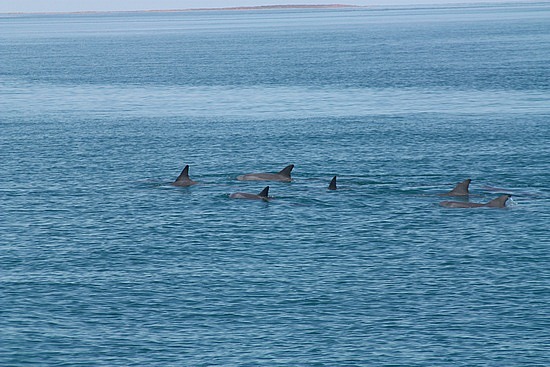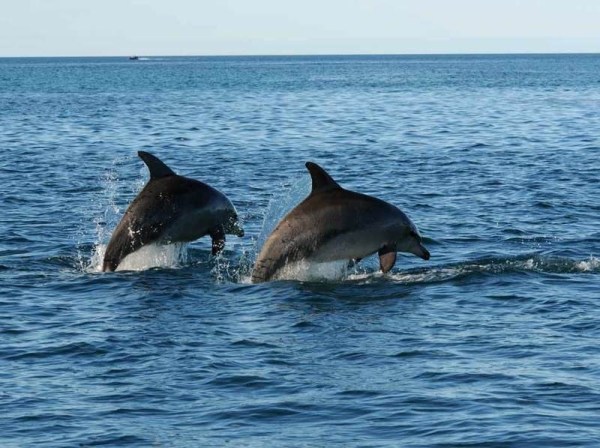As discussed in detail in a recent AnimalWise post, a group of female bottlenose dolphins in Shark Bay, Western Australia has enjoyed quite a bit of attention of late for creatively using marine basket sponges as tools to assist them in rooting out bottom-dwelling fish. While the spotlight has been on the females, not much has been said about the males who (despite growing up fin-to-fin with sisters who learn how to use sponges) generally do not become spongers. The researchers studying the sponging behavior have not explored the lack of male sponging in depth, but have hypothesized that the males may be too focused on establishing and maintaining “alliances” to be able to devote the time and effort necessary to become specialized sponge-using foragers.1
So what are these male alliances all about, and why are they so important?
Fortunately, a study published in the August 23, 2011 issue of Biology Letters2 provides some new detail and insight into male bottlenose dolphin alliances in Shark Bay.
In a surprise to most likely no one, the alliances are all about sex – maximizing a male’s chances of being able to mate. What is surprising, however, is the level of complexity of these male relationships.
Only humans and Shark Bay bottlenose dolphins are known to have multiple-level male alliances within a social network.
The researchers already knew that the Shark Bay males formed two distinct levels of alliance: first-order groupings of three (or, less frequently, two) males who cooperate to establish and maintain “consortships” with females, and second-order alliances comprised of two or more primary groups who band together to take females from other alliances and/or to defend against such “theft” attempts.
In itself, this degree of cooperation is notable, as alliances and coalitions within social groups are considered to be a hallmark of social complexity (for a posting on female elephant social networks, see here, and for hyena social dynamics, see here). The researchers put it succinctly: “Only humans and Shark Bay bottlenose dolphins are known to have multiple-level male alliances within a social network.” (AnimalWise aside: why are males less apt to have multi-tier social networks than females? Ok, perhaps I don’t need to ask….)

Are you in my second-order alliance? This is all so complicated! (photo credit: Shark Bay Dolphin Project)
In this most recent study, the research team describes a Shark Bay male dolphin society that is even more complex than previously reported – one that actually has three levels of nested alliances among males.
The researchers spent over five years observing 121 frequently-seen males in over 500 consortships, concluding that amicable low-level associations (i.e., third-order alliances) were regularly occurring between specific second-order alliances and trios or other second-order alliances. The researchers further noted that fights involving multiple groups of males suggested that the third-order alliances, like the second-order ones, are employed in conflicts over females, as higher-order alliances could be useful if second-order partners were not around when rivals appeared.
A few other interesting research findings include:
- There was a nearly continuous range in the size of second-order alliances, which had between six and 14 members.
- There did not appear to be a relationship between the size of the second-order alliances and how stable (long-lasting) their component first-order trios were.
- Most of the males participated in second-order alliances, but a subset of five trios did not. Of these five trios, four were comprised of older males whose prior second-order alliance partners had disappeared over time. The researchers surmised that these particular dolphins may have participated in third-order alliances because they were particularly in need of assistance in protecting and obtaining females.
- Most of the first-order trios associated with only one second-order alliance, but a small subset (around 3%) associated with more than one second-order alliance.
So, to sum up, while (a subset of about 1/11 of) the female bottlenoses of Shark Bay are engaging in specialized tool use with marine sponges, the males are absorbed in complex Machiavellian political relationships and sexual maneuvering. Hmm, sounds a bit familiar.
_____
1Mann, J., Sargeant, B., Watson-Capps, J., Gibson, Q., Heithaus, M., Connor, R., & Patterson, E. (2008). Why Do Dolphins Carry Sponges? PLoS ONE, 3 (12) DOI: 10.1371/journal.pone.0003868.
2Connor, R., Watson-Capps, J., Sherwin, W., & Krutzen, M. (2010). A new level of complexity in the male alliance networks of Indian Ocean bottlenose dolphins (Tursiops sp.) Biology Letters, 7 (4), 623-626 DOI: 10.1098/rsbl.2010.0852.

